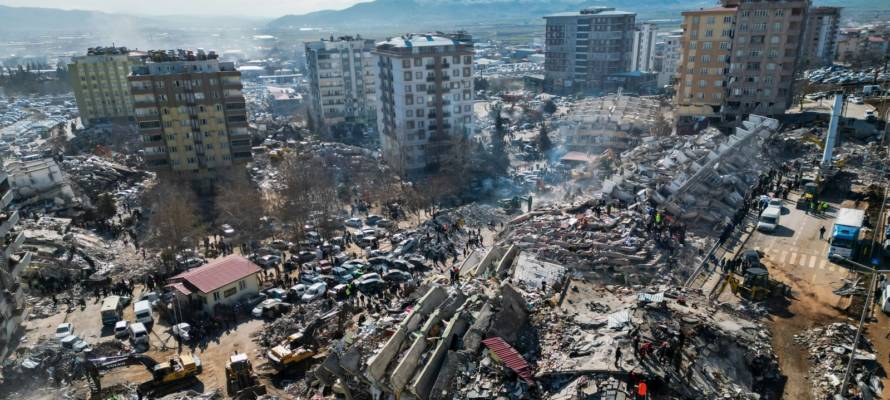If an earthquake hits at sea no-one knows until it’s too late. But an Israeli professor believes there’s a cheap and easy early warning solution – the fiber optic communication cables on the seabed.
By Judith Sudilovsky, Israel21c
In an earthquake, it’s the first seconds that can make all the difference in whether you are likely to survive. With enough time, you can get out of a building or your car, or find some kind of protection – a secure room, a staircase or even a strong piece of furniture. Without this warning, your fate is in the hands of luck alone.
It’s something on everyone’s minds these days after the devastating earthquake that hit Turkey and Syria unexpectedly on February 6, in the early hours of the morning when most people were asleep, leaving over 15,000 dead, and thousands more injured or missing.
Now an Israeli professor believes he has a solution that could give people an extra half a minute warning more than current methods, and which uses an existing infrastructure – the fiber optic cables deployed on the seabed worldwide for internet communication.
“At the current stage we can’t predict when an earthquake will occur, but we know there are places in the world along fault lines that produce earthquakes,” said Dr. Itzhak Lior, senior lecturer in the Institute of Earth Sciences at Hebrew University and a specialist in earthquake seismology.
“The thing we can do to prepare is to build properly according to engineering codes, which costs a lot of money and takes time. Meanwhile, a less expensive and less time-consuming way it so set up early warning systems,” he said.
In a study, Lior led an international team of researchers at Hebrew University of Jerusalem who analyzed data from earthquakes recorded by several optical fibers deployed on the seabed off the coasts of Greece, France and Chile.
The study, published in Nature’s Scientific Reports journal, demonstrates that existing fiber optics cables on the seabed, can detect seabed earthquakes half a minute earlier than current methods.
Today there are already some earthquake monitoring technologies that can rapidly provide early warning for earthquakes on land, but those that occur on the seabed are usually detected up to tens of seconds after they start.
Offshore earthquakes often the worst
However, as Lior points out, the largest and most damaging earthquakes on Earth occur offshore, and their late detection significantly shortens warning times and the ability to prepare for them.
Think about the 9.1 magnitude 2011 earthquake off the coast of Japan, which caused a massive 40.5 meter tsunami and killed nearly 20,000 people, or the 2004 earthquake in the Indian Ocean, which also caused a massive tsunami that hit 14 countries, left 230,000 people dead and was the third largest earthquake in recorded history.
“Earthquakes that occur under the seabed or in areas without sensors can result in delayed detection by existing technologies, which hinders preparation,” explained Lior.
Using data from the fiber optic cables, earthquakes on the seabed could be alerted for up to half a minute earlier than standard methods – critical seconds that can save human lives. It would also provide critical information on the estimated magnitude of a predicted earthquake.
“People would know what is happening and would be able to prepare themselves in those few extra seconds, to get out of their car, slow down trains, divert planes, automatically disconnect gas lines,” said Lior.
“Those extra seconds are enough so people can go into shelters, get out of their apartments or get beneath heavy furniture.”
Lior say these findings demonstrate that using existing fiber infrastructure can simplify and speed up the establishment and operation of earthquake warning systems, as well as improve warning times.
“There are tremendous amounts of ocean bottom cables,” Lior explained, and technology using optical fibers to monitor earthquakes began roughly five years ago.
In order to measure the data, an optical interrogator unit is located on the land end of the off-shore fiber cable and sends back the information to a computer for analysis.
“It is an easy fit with the technology, we just need to build the algorithms to analyze the data recorded by the optical fibers,” he said.
While on shore it is possible to put the sensors on the fault lines, the technological problem is how to obtain the data close enough to where the earthquake would occur on fault lines offshore, he said.
The measurement system for fiber optic cables already exists, and several companies manufacture and sell them, said Lior.
“We can (already) record earthquakes using optical fibers. What I’m studying is how we can use these measurements to produce early warnings,” he explained, adding that it could be operational in a few years.
While at such an early stage it is not clear who would be the institutions to operate such a warning system, especially in developing countries, but national early warning systems in many regions around the world are operated by governmental agencies such as the geological survey but there are also private companies that sell and operate such systems, said Lior.
“Using communication fibers from commercial companies is a very significant advantage for areas that are at risk of earthquakes such as Chile, Japan, the west coast of North America, and also Israel,” said Lior.
“This can also help in developing countries where they don’t have (other) seismic instruments. It can produce warnings much faster than using standard approaches and can give people more time to prepare for an earthquake. It can save many lives and prevent injuries,” he added.
While the new system can give an early warning, Lior admits it still can’t predict when an earthquake will occur.
“We know where they are likely to occur, but we don’t know the when,” he said. “We can study them to better understand them and prepare for them, but at the end of the day we can’t predict them. We are still just one small person (in front of Mother Nature.)”
REBUILD ISRAELI FARMS DESTROYED BY HAMAS - PLANT TREES!
ISRAELI FARMERS DESPERATELY NEED YOUR YOUR HELP
Hamas tried to destroy everything. Terrorists murdered 1200 innocent Israelis. Join us in planting 12,000 trees of life to honor the victims. Send blessing to the People and Land of Israel.
“…I will ordain My blessing for you…” (Leviticus 25:4,21)
JOIN OUR CAMPAIGN TO PLANT 12,000 NEW FRUIT TREES ACROSS THE LAND OF ISRAEL!




